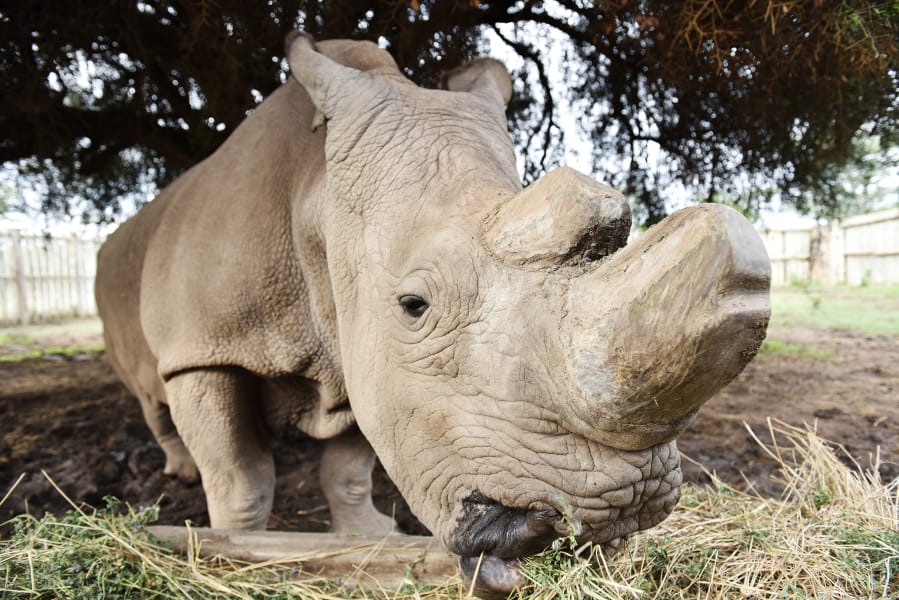The beleaguered northern white rhinoceros moved closer to extinction last week after conservationists announced that the health of the only surviving male of the species was deteriorating.
The rhino, named Sudan, made headlines last year after it was dubbed “The Most Eligible Bachelor in the World” on the dating app Tinder as part of a campaign to spread awareness about rhinos and raise money to help protect them.
But now Sudan’s days appear to be numbered.
He was “starting to show signs of ailing,” according to a statement posted Wednesday on Twitter by the Ol Pejeta Conservancy, the preserve in Kenya where the 45-year-old rhino has lived since 2009. “His health has begun deteriorating, and his future is not looking bright.”
“We are very concerned about him — he’s extremely old for a rhino and we do not want him to suffer unnecessarily,” it said. White rhinos live until around 40 on average, though those being cared for in captivity can survive longer.
Sudan developed “an uncomfortable age-related infection on his back right leg” at the end of 2017, the conservancy said. A team of veterinarians from around the world assessed the animal, which responded well to treatment and began to heal, soon resuming normal movement and foraging habits.
But recently, a secondary and much deeper infection was discovered beneath the initial one and Sudan was taking longer to recover, “despite the best efforts of his team of vets who are giving him 24-hour care,” the organization said.
There are two other white rhinos left in the world — a female named Najin and daughter Fatu, both also living at the conservancy in Kenya. Health problems or their ages — around 28 and 17, respectively — have left them unable to reproduce.
Wildlife experts and conservationists expressed deep regret over the prospect of the northern white rhino completely dying out. Technically, the species is already classified as extinct because it no longer exists in the wild, conservationists said.
“This is a distinct lineage of white rhino,” said Barbara Durrant, director of reproductive sciences at San Diego Zoo Global. “The loss of a population, especially of a mega vertebrae like a rhino … is a significant loss in terms of genetic diversity.”
The zoo has had eight northern white rhinos in its safari park over the years since 1972. The last one, a female named Nola, died in 2015.
All types of rhino are threatened. No more than 26,543 are left in Africa, and no more than 163 in Southeast Asia, along with at least 3,500 in other parts of Asia, according to Save the Rhino, a conservation charity based in Britain.
Poaching is the main cause of the decline and disappearance of rhinos from the wild. They are hunted for their horns, which are trafficked primarily in China and Vietnam for such uses as cures for illness.
More than 7,245 African rhinos have been lost to poaching over the last decade, including 1,028 last year in South Africa, according to Save the Rhino.
The poaching danger is often coupled with degradation and loss of habitat and the vulnerability the animals face living in conflict zones, said Bas Huijbregts, who leads the World Wildlife Fund’s wildlife conservation efforts in Africa.
The habitat of the northern white rhino included Congo, South Sudan and the Central African Republic — nations racked by war, political strife and lack of governance.
The northern white rhino “had the unfortunate characteristic of living in one of Africa’s most unstable regions,” Huijbregts said.
Various initiatives are being explored to preserve the species or possibly reintroduce it after the three remaining rhinos die. They include collecting the eggs from the ovaries of at least the younger of the two female northern white rhinos for possible in-vitro fertilization.
“That hasn’t happened yet, but the technique is being optimized,” Durrant said.
San Diego’s Frozen Zoo is among at least two research facilities that already have northern white rhino semen.




